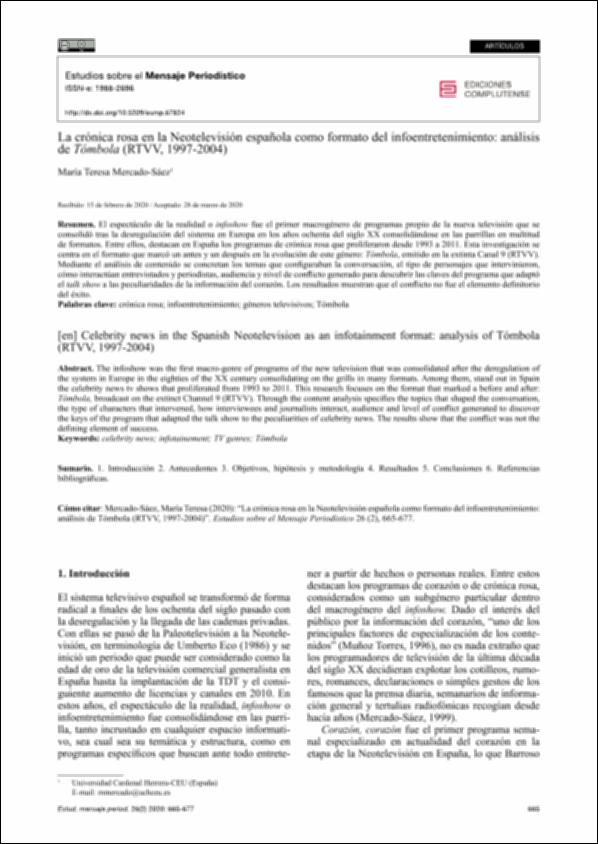Please use this identifier to cite or link to this item:
http://hdl.handle.net/10637/12781La crónica rosa en la neotelevisión española como formato del infoentretenimiento: análisis de Tómbola (RTVV, 1997-2004)
| Title: | La crónica rosa en la neotelevisión española como formato del infoentretenimiento: análisis de Tómbola (RTVV, 1997-2004) |
| Other Titles: | Celebrity news in the Spanish neotelevision as an infotainment format : analysis of Tómbola (RTVV, 1997-2004) |
| Authors : | Mercado Sáez, María Teresa. |
| Keywords: | Radiotelevisión Valenciana (RTVV) Análisis de contenido.; RadioTelevisión Valenciana (RTVV) Content analysis.; Sensacionalismo en televisión - España - Comunidad Valenciana.; Public-Access television - Spain - Valencia (Autonomous Community); Television - Spanish autonomous communities - Content analysis - Spain - Valencia (Autonomous Community); Sensationalism on television - Spain - Valencia (Autonomous Community); Televisión pública - España - Comunidad Valenciana.; Energía nuclear - Aspectos ambientales - España.; Televisión - Programas - Análisis de contenido - España - Comunidad Valenciana.; Television - Programs - Content analysis - Spain - Valencia (Autonomous Community); Televisión autonómica - Análisis de contenido - España - Comunidad Valenciana. |
| Publisher: | Universidad Complutense de Madrid, Servicio de Publicaciones. |
| Citation: | Mercado Saez, M. T. (2020). La crónica rosa en la neotelevisión española como formato del infoentretenimiento: análisis de Tómbola (RTVV, 1997-2004). Estudios sobre el mensaje periodístico, vol. 26, n. 2, (04 abr.), pp. 665-677. DOI: https://doi.org/10.5209/esmp.67824 |
| Abstract: | El espectáculo de la realidad o infoshow fue el primer macrogénero de programas propio de la nueva televisión que se consolidó tras la desregulación del sistema en Europa en los años ochenta del siglo XX consolidándose en las parrillas en multitud de formatos. Entre ellos, destacan en España los programas de crónica rosa que proliferaron desde 1993 a 2011. Esta investigación se centra en el formato que marcó un antes y un después en la evolución de este género: Tómbola, emitido en la extinta Canal 9 (RTVV). Mediante el análisis de contenido se concretan los temas que configuraban la conversación, el tipo de personajes que intervinieron, cómo interactúan entrevistados y periodistas, audiencia y nivel de conflicto generado para descubrir las claves del programa que adaptó el talk show a las peculiaridades de la información del corazón. Los resultados muestran que el conflicto no fue el elemento definitorio del éxito. / The infoshow was the first macro-genre of programs of the new television that was consolidated after the deregulation of the system in Europe in the eighties of the XX century consolidating on the grills in many formats. Among them, stand out in Spain the celebrity news tv shows that proliferated from 1993 to 2011. This research focuses on the format that marked a before and after: Tómbola, broadcast on the extinct Channel 9 (RTVV). Through the content analysis specifies the topics that shaped the conversation, the type of characters that intervened, how interviewees and journalists interact, audience and level of conflict generated to discover the keys of the program that adapted the talk show to the peculiarities of celebrity news. The results show that the conflict was not the defining element of success. |
| Description: | Este artículo se encuentra disponible a texto completo en la siguiente URL: https://revistas.ucm.es/index.php/ESMP/article/view/67824/4564456553293 Este número monográfico de la revista Estudios sobre el Mensaje Periodístico lleva por título "Programación y programas de televisión en España desde la desregulación: 1990-2020". |
| URI: | http://hdl.handle.net/10637/12781 |
| Rights : | http://creativecommons.org/licenses/by/4.0/deed.es |
| ISSN: | 1134-1629. 1988-2696 (Electrónico). |
| Issue Date: | 4-Apr-2020 |
| Center : | Universidad Cardenal Herrera-CEU |
| Appears in Collections: | Dpto. Comunicación e Información Periodística |
Items in DSpace are protected by copyright, with all rights reserved, unless otherwise indicated.


